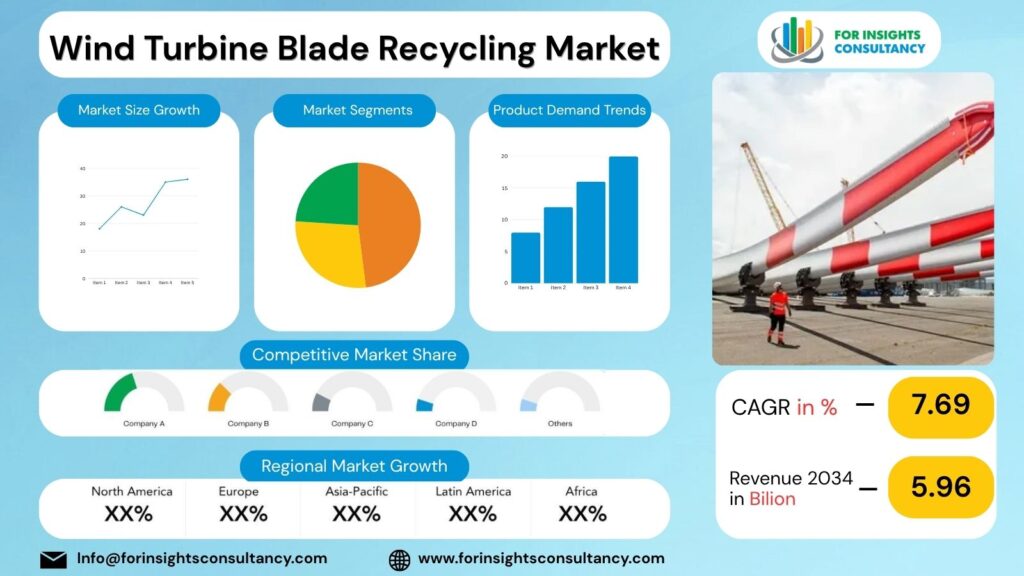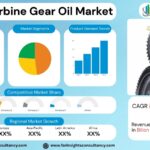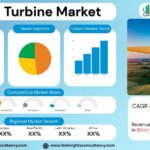
Wind Turbine Blade Recycling Market Size, Trends Analysis Research Report By Material Type (Thermoset Composites, Thermoplastic Composites), by Process (Mechanical Recycling, Thermal Recycling, Chemical Recycling), by Application, by End User, and By Region Global Market Analysis And Forecast, 2025-2034
Nov-2025 Formats | PDF | Category: Energy & Power | Delivery: 24 to 72 Hours
Global revenue from the Wind Turbine Blade Recycling market is projected at US$ 3.8 Billion in 2025 and has been blunt to existing at a CAGR of 4.58% to extent US$ 5.96 Billion by the end of 2034.
Wind Turbine Blade Recycling Market Research Summary
Recycling of wind turbine blades is becoming a popular market due to the abundance of the blades that are being taken out of service globally. The need for clean energy is accompanied by the need for environmentally friendly disposal of those big waste structures made of composites, which have been used in the energy sector.
One of the major issues in recycling of wind turbine blades is that they are made of complex composite materials that are difficult to separate and recycle, hence the process is expensive and technically challenging. Nevertheless, there are new technologies and collaborations that are rising to solve these difficulties.
Eventually, the wind turbine blade recycling market will turn to the use of recycling methods such as pyrolysis and chemical recycling; next, we will see initiatives that promote circular economy for turbine blades via reuse and remanufacturing.
Along with industrial players, governments are committed to the issue of sustainable end-of-life solutions for wind turbine blades. This is resulting in the drafting of laws and the setting of standards that will contribute to the spread of good recycling practices which are less polluting.
The wind turbine blade recycling market will expand in the future. This growth will be fueled by the requirement for environmentally friendly waste disposal solutions and the progress in technology. The stakeholders need to be engaged in cooperation and continuous innovation to find solutions to the obstacles and pave the way for a more sustainable future.
Market Insights
By 2024, the Wind Turbine Blade Recycling Market will have an impressive growth figure with Europe being the leading region in terms of revenue share because of the strict environmental regulations and the heightened focus on sustainability. The growth potential of the European market is estimated to be around 25%, which is a very strong indication of the market potential. The United States, on the other hand, has a predominantly urban population with about 82% of the population living in cities, thus making it a huge market for renewable energy sources like the wind turbine blade recycling industry.
Concerning the market segments, the repurposing and remanufacturing segment is going to be the one that will hold the most significant revenue share, which is a reflection of the industry’s commitment to the circular economy principles and to the reduction of waste. In general, the Wind Turbine Blade Recycling Market is very much likely to extend its reach in a short period of time, which is a result of the environmental issues and the technological progress.
Market Dynamics
Trends
Adoption of Circular Economy Practices: There will be a wave of adoption of circular economy principles in the market which will lead to the efficient use of resources and less waste generation.
Technological Innovations: The research and development activities that are ongoing will be a source of technological innovations in the methods of recycling wind turbine blades that will result in great efficiency and sustainability.
Government Regulations and Incentives: The growth of the market will be influenced by the increasing number of government regulations that focus on environmental sustainability. The adoption of recycling practices will be facilitated by such incentives as tax credits and subsidies.
Industry Collaboration: The collaboration between wind turbine manufacturers, recyclers, and research institutions will be deepening thus facilitating knowledge-sharing and picking up the pace of recycling technologies.
Market Expansion: The wind turbine blade recycling market will spread worldwide due to the increasing demand for clean energy sources and the resulting surge in the use of wind energy.
Growth Drivers
The expanding wind turbine blade recycling market will be the result of government initiatives and regulations that emphasize sustainable waste management and circular economy practices.
A developer’s and operator’s solid green awareness of the end-of-life turbine blades’ environmental impact will, therefore, create a demand for recycling services, which in turn will increase the market.
It is expected that innovations in recycling technologies, for example, pyrolysis and chemical recycling, will make the recycling of wind turbine blades more efficient and less costly, thus, a technique of market growth.
The increased budget for the research and development of futuristic and innovative recycling technologies and materials during the forecast period is likely to become the next market expansion area with untapped opportunities.
Restraints
Expensive recycling of wind turbine blade wastes: The recycling procedure of wind turbine blades might be costly because of the necessity for specialized equipment and technology, thus creating a financial problem for market players.
Insufficient recycling network: The absence of appropriate recycling facilities and infrastructure can obstruct the recycling of wind turbine blades and thus lead to the market’s slow growth.
First, some of the concerned people may worry about the environmental impact of the recycling process, for example, carbon emissions and waste production. This may restrict the market to expand in the following years.
During 2024-2025, stringent regulations and policies regarding waste management and recycling practices will be sources of compliance challenges for companies in the wind turbine blade recycling market.
Opportunities
Increasing Focus on Sustainable Practices: The concern for the environment has led to a demand for sustainable solutions, thus opening up opportunities for the recycling of wind turbine blades.
Government Initiatives and Regulations: To comply with stricter regulations on waste management imposed by authorities worldwide, companies are encouraged to invest in recycling technologies for wind turbine blades through the provision of incentives.
Technological Innovations: To a great extent, the advancements in recycling technologies have made it possible to have more efficient and cost-effective methods of handling wind turbine blades, thus there are abundant new opportunities in this market.
Growth in Wind Energy Sector: The development of the wind energy sector is a driving force behind the demand for wind turbine blades, thus there is a growing need for the provision of recycling solutions that will efficiently handle the management of end-of-life blades.
Challenges
Volume of Decommissioned Blades Exceeding: The increase in the number of desultory wind turbines will cause the volume of decommissioned blades to rise in such a way that logistics and operational challenges will be posed.
Insufficient Recycling Technologies: The absence of advanced and affordable recycling technologies, especially for wind turbine blades, is a major challenge that paves the way for inefficiency in recycling composite materials.
Social Concerns: The main challenges to be solved soon are the ones related to finding proper disposal methods for non-recyclable parts of blades and the environmental impact of the recycling process for blades.
Complying with Regulations: Changes in rules and standards regarding waste management, recycling, and environmental protection may create difficulties in compliance for stakeholders in the wind turbine blade recycling market.
Market Feasibility: The issue of balancing the recycling operation costs against the revenue generated from recycled materials and products is the major economic challenge for industry players in the Wind Turbine Blade Recycling Market.
Wind Turbine Blade Recycling Market Top Companies Covered In This Report:
Evaluate The Strategic Positioning And Innovation Pipelines Of Leading Market Companies-From Multinational Enterprises To Disruptive Regional Firms. Understand How Key Players Are Innovating, Expanding, And Capturing Value, And Use Competitive Benchmarks To Plan Your Next Move.
- Global Fiberglass Solutions
- Veolia Environmental Services
- SUEZ
- BladeBUG
- RESINEXX
- GE Renewable Energy
- Vestas Wind Systems
- Siemens Gamesa Renewable Energy
- EDF Renewables
- Enel Green Power
Wind Turbine Blade Recycling Market Company News 2024 and 2025
Global Fiberglass Solutions
Global Fiberglass Solutions announced advancements in mechanical recycling technologies to convert decommissioned blades into reusable materials for construction.
Veolia Environmental Services
Veolia Environmental Services expanded its partnerships for large-scale wind blade recycling facilities in Europe.
SUEZ
SUEZ launched new chemical recycling solutions aimed at improving sustainability and reducing carbon emissions in blade disposal.
GE Renewable Energy
GE Renewable Energy collaborated with Veolia to recycle wind blades into raw materials for cement production.
Key Segments
Segmentation By Material Type
- Thermoset Composites
- Thermoplastic Composites
Segmentation By Process
- Mechanical Recycling
- Thermal Recycling
- Chemical Recycling
Segmentation By Application
- Cement Co-processing
- Composites Reuse
- Energy Recovery
- Other Applications
Segmentation by End User
- Wind Energy
- Construction
- Automotive
- Aerospace
Global Geographic Coverage:
The Report Provides In-Depth Qualitative And Quantitative Data On The Wind Turbine Blade Recycling Market For All Of The Regions And Countries Listed Below:
North America
The North American Wind Turbine Blade Recycling Market is expected to expand significantly, supported by the region’s environmentally friendly energy policies. The expected GDP growth of 4.5% and the moderate inflation rate of 2% are indicative of a hospitable economic setting for this market.
In the United States, the establishment of a government subsidy for renewable energy projects is a major non-replicable factor that has a profound influence on the wind turbine blade recycling market. The subsidy attracted companies to the green energy industry by reducing their costs, thereby creating a demand for the recycling sector.
In North America, the primary method of wind turbine blade recycling is through collaborations with renewable energy companies, whereas the most rapidly expanding method is the direct involvement of consumers through awareness campaigns and educational initiatives.
Customers in North America are very concerned about the environment and demand that products be sourced ethically. In such a case, in numerous emerging markets where the price and status are still the main factors, a company that highlights its environmental-friendly and ethical attributes will have a competitive advantage and attract the conscious consumers.
Europe
The European Wind Turbine Blade Recycling Market keeps expanding at a slow but steady pace, which is largely due to the continent’s anticipated GDP growth of 1.7% and an inflation rate of 1.4%. In the Netherlands, this market is being energized by a local driver which is a government subsidy aimed at supporting sustainable practices in the energy sector. The subsidy has, therefore, been the main reason for the increased demand for wind turbine blade recycling in the country. The main channel for these products is through specialized waste management companies, whereas the quickest expanding channel is online platforms that facilitate recyclers and manufacturers communication.
Consumers in Europe are becoming more and more sustainable and ethical in their choices regarding the purchase of wind turbine blades, which makes these features mandatory in the market. In a number of emerging markets, for instance, Eastern Europe, the price and status are still the main factors that influence consumer preferences, thus creating a problem for sustainability-focused businesses that want to enter these markets.
Asia Pacific
The area of Wind Turbine Blade Recycling in Asia Pacific is expected to undergo significant growth over the next years, thanks to the region’s strong GDP growth of 5% and moderate inflation rate of 2%. A government subsidy dedicated to wind turbine blade recycling in Japan has been the main factor in the market growth, thus it is the most noticeable in the region. The main channel of the industry in Japan is through cooperation with local recycling facilities, whereas the fastest channel is direct-to-consumer activities that create awareness about sustainability and ethical sourcing. In several emerging markets of the Asia Pacific, consumers mainly focus on price and status and hardly consider factors like sustainability, ethical sourcing, or localism, which poses a challenge for companies to promote these values efficiently. Still, the market is opening up to further development in the region.
Middle East and Africa
The Wind Turbine Blade Recycling Market in the Middle East and Africa is experiencing a surge of energy due to the forecasted GDP growth of 3% and a consistent inflation rate of 2%. The market in the area is mainly propelled by a solitary government subsidy in South Africa, which makes it a non-replicable driver in this country. The major channel for wind turbine blade recycling is through the establishment of relationships with local waste management companies, whereas the quickest developing channel is direct-to-consumer initiatives. Consumers in this area are focusing on sustainability, ethical sourcing, and localism as far as wind turbine products are concerned. Nevertheless, in a number of emerging markets in the Middle East and Africa, price and status still lead the way in terms of consumer preferences.
Frequently Asking Questions
What is the Wind Turbine Blade Recycling market size and growth forecast?
Wind Turbine Blade Recycling Market is predicted to grow from USD 3.8 Billion in 2025 to approximately USD 5.96 Billion by 2034. the industry is estimated to expand at a CAGR of 4.58%.
Who are the key players in the Wind Turbine Blade Recycling market?
The Wind Turbine Blade Recycling Market Includes Major Companies SUEZ, BladeBUG, RESINEXX, Global Fiberglass Solutions, GE Renewable Energy, Vestas Wind Systems, Siemens Gamesa Renewable Energy, EDF Renewables, Enel Green Power, Veolia Environmental Services, Others.
What are the current and future trends for Wind Turbine Blade Recycling market?
Current trend: Increasing demand for sustainable practices driving growth in the Wind Turbine Blade Recycling market. Future trend: Advancements in technology leading to more efficient and cost-effective recycling methods for wind turbine blades.
What are the challenges facing the Wind Turbine Blade Recycling market?
The main challenge facing the Wind Turbine Blade Recycling market is the lack of efficient and cost-effective recycling technologies for composite materials.
Which regions dominate the Wind Turbine Blade Recycling market?
Europe and North America dominate the Wind Turbine Blade Recycling market due to established recycling infrastructure and government regulations promoting sustainable practices.
Report Features
This report gives the most complete information. The report on Wind Turbine Blade Recycling Market format has been designed so that it can provide the best value to the business. It offers crucial insights into the market’s dynamic and will aid in strategic decision-making for current players as well as those looking to join the market.
What Deliverables Will You Get in this Report?
Key questions this report answers | Relevant contents in the report |
How big is the sales opportunity? | In-depth analysis of the Global Wind Turbine Blade Recycling Market |
How lucrative is the future? | Market forecast and trend data and emerging trends |
Which regions offer the best sales opportunities? | Global, regional and country level historical data and forecasts |
Which are the most attractive Wind Turbine Blade Recycling market Key segments? | Market segment analysis and |
Which are the top Key players and Their Wind Turbine Blade Recycling market positioning? | Competitive landscape analysis, Market share analysis |
How complex is the business environment? | Porter’s five forces analysis, PEST analysis, Life cycle analysis |
What are the factors affecting the Wind Turbine Blade Recycling market? | Drivers & Restraints |
Will I get the information on my | Customized Report as per your Business Needs Our analysts will work directly with you and understand your needs Get data on specified regions or segments, competitor and Vendors Data will be formatted and presented as per your requirements Any Requirement Contact Us: Https://Www.Forinsightsconsultancy.Com/Contact-Us |
Table of Contents
For TOC Contact us: https://forinsightsconsultancy.com/contact-us/







